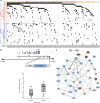Analyzing tumor heterogeneity and driver genes in single myeloid leukemia cells with SBCapSeq
- PMID: 27479497
- PMCID: PMC6124494
- DOI: 10.1038/nbt.3637
Analyzing tumor heterogeneity and driver genes in single myeloid leukemia cells with SBCapSeq
Abstract
A central challenge in oncology is how to kill tumors containing heterogeneous cell populations defined by different combinations of mutated genes. Identifying these mutated genes and understanding how they cooperate requires single-cell analysis, but current single-cell analytic methods, such as PCR-based strategies or whole-exome sequencing, are biased, lack sequencing depth or are cost prohibitive. Transposon-based mutagenesis allows the identification of early cancer drivers, but current sequencing methods have limitations that prevent single-cell analysis. We report a liquid-phase, capture-based sequencing and bioinformatics pipeline, Sleeping Beauty (SB) capture hybridization sequencing (SBCapSeq), that facilitates sequencing of transposon insertion sites from single tumor cells in a SB mouse model of myeloid leukemia (ML). SBCapSeq analysis of just 26 cells from one tumor revealed the tumor's major clonal subpopulations, enabled detection of clonal insertion events not detected by other sequencing methods and led to the identification of dominant subclones, each containing a unique pair of interacting gene drivers along with three to six cooperating cancer genes with SB-driven expression changes.
Conflict of interest statement
The authors declare no competing financial interests.
Figures







References
-
- Mann MB, Jenkins NA, Copeland NG, Mann KM. Sleeping Beauty mutagenesis: exploiting forward genetic screens for cancer gene discovery. Curr. Opin. Genet. Dev. 2014;24:16–22. - PubMed
-
- Mann KM, Jenkins NA, Copeland NG, Mann MB. Transposon insertional mutagenesis models of cancer. Cold Spring Harb. Protoc. 2014;2014:235–247. - PubMed
-
- Takeda H, et al. Transposon mutagenesis identifies genes and evolutionary forces driving gastrointestinal tract tumor progression. Nat. Genet. 2015;47:142–150. - PubMed
Publication types
MeSH terms
Substances
Grants and funding
LinkOut - more resources
Full Text Sources
Other Literature Sources
Molecular Biology Databases

